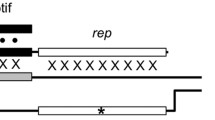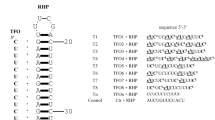Abstract
A potentially powerful pharmacological approach to modulating the expression of specific, disease-related genes involves the inhibition of transcription factor binding to promoter or enhancer elements through oligonucleotide-mediated triple-helix formation. In vivo, the typical target for intermolecular triplex formation would most likely be torsionally-strained rather than relaxed duplex DNA. To determine the effects of strained DNA on triplex formation, we investigated the interactions between a G/T rich oligonucleotide and both supercoiled and relaxed plasmid DNA using a restriction endonuclease protection assay. Both the kinetics of formation and dissociation of purine-motif triplexes were unaffected by the conformational state of the duplex DNA. Similarly, the topological state of the plasmid targets was not affected by triplex formation. Taken together, these observations suggest that stable intermolecular triplexes can form in vivo under conditions of moderate torsional strain.
Similar content being viewed by others
References
Hélène C: The anti-gene strategy: control of gene expression by triplexforming oligonucleotides. Anticancer Drug Des 6: 569–584, 1991
Maher LJ III: DNA triple-helix formation: an approach to artificial gene repressors. BioEssays 14: 807–815, 1992
Cooney M, Czemuszewicz G, Postel EH, Flint SJ, Hogan ME: Sitespecific oligonucleotide binding represses transcription of the human c-myc gene in vitro. Science 241: 456–459, 1988
Postel EH, Flint SJ, Kessler DJ, Hogan ME: Evidence that a triplexforming oligodeoxyribonucleotide binds to the c-myc promoter in HeLa cells, thereby reducing c-myc mRNA levels. Proc Natl Acad Sci USA 88: 8227–8231, 1991
Orson FM, Thomas DW, McShan WM, Kessler DJ, Hogan ME: Oligonucleotide inhibition of IL2Rα mRNA transcription by promoter collinear triplex formation in lymphocytes. Nucleic Acids Res 19: 3435–3441, 1991
Maher LJ III, Dervan PB, Wold BJ: Analysis of promoter-specific repression by triple-helical DNA in a eukaryotic cell-free transcription system. Biochemistry 31: 70–81, 1992
Grigoriev M, Praseuth D, Robin P, Hemar A, Saison-Behmoaras T, Dautry-Varsat A, Thuong NT, Hélène C, Harel-Bellan A: A triple helixforming oligonucleotide-intercalator conjugate acts as a transcriptional repressor via inhibition of NF-KB binding to interleukin-2 receptor α regulatory sequence. J Biol Chem 267: 3389–3395, 1992
McShan WM, Rossen RD, Laughter AH, Trial J, Kessler DJ, Zendegui JG, Hogan ME, Orson FM: Inhibition of transcription of HIV-1 in infected human cells by oligonucleotides designed to form DNA triple helicies. J Biol Chem 267: 5712–5721, 1992
Grigoriev M, Praseuth D, Guieysse AL, Robin P, Thuong NT, Helene C, Harel-Bellan A: Inhibition of gene expression by triple helixdirected DNA cross-linking at specific sites. Proc Natl Acad Sci USA 90: 3501–3505, 1993
Ing NH, Beekman JM, Kessler DJ, Murphy M, Jayaraman K, Zendegui JG, Hogan ME, O'Malley BW, Tsai MJ: In vivo transcription of a progesterone-responsive gene is specifically inhibited by a triplexforming oligonucleotide. Nucleic Acids Res 21: 2789–2796, 1993
Roy C: Inhibition of gene transcription by purine rich triplex forming oligodeoxyribonucleotides. Nucleic Acids Res 21: 2845–2852, 1993
Ebbinghaus SW, Gee JE, Rodu B, Mayfield CA, Sanders G, Miller DM: Triplex formation inhibits HER-2/neu transcription in vitro. J Clin Invest 92: 2433–2439, 1993
Roy C: Triple-helix formation interferes with the transcription and hinged DNA structure of the interferon-inducible 6–16 gene promoter. Eur J Biochem 220: 493–503, 1994
Hobbs CA, Yoon K: Differential regulation of gene expression in vivo by triple helix-forming oligonucleotides as detected by a reporter enzyme. Antisense Res Dev 4: 1–8, 1994
Imagawa S, Izumi T, Miura Y: Positive and negative regulation of the erythropoietin gene. J Biol Chem 269: 9038–9044, 1994
Degols G, Clarenc JP, Lebleu B, Léonetti JP: Reversible inhibition of gene expression by a psoralen functionalized triple helix forming oligonucleotide in intact cells. J Biol Chem 269: 16933–16937, 1994
Mayfield C, Ebbinghaus S, Gee J, Jones D, Rodu B, Squibb M, Miller D: Triplex formation by the human Ha-ras promoter inhibits Spl binding and in vitro transcription. J Biol Chem 269: 18232–18238, 1994
van Holde K, Zlatanova J: Unusual DNA structures, chromatin and transcription. BioEssays 16: 59–68, 1993
Wang JC, Lynch AS: Transcription and DNA supercoiling. Curr Opin Genet Dev 3: 764–768, 1993
Liu LF, Wang JC: Supercoiling of the DNA template during transcription. Proc Natl Acad Sci USA 84: 7024–7027, 1987
Giaever GN, Wang JC: Supercoiling of intracellular DNA can occur in eukaryotic cells. Cell 55: 849–856, 1988
Pederson DS, Morse RH: Effect of transcription of yeast chromatin on DNA topology in vivo. EMBO J 9: 1873–1881, 1990
Palecek E: Local supercoil-stabilized DNA structures. Crit Rev Biochem Mol Biol 26: 151–226, 1991
Wells RD, Collier DA, Hanvey JC, Shimizu M, Wohlrab F: The chemistry and biology of unusual DNA structures adopted by oligopurine-oligopyrimidine sequences. FASEB J 2: 2939–2949, 1988
Htun H, Dahlberg JE: Topology and formation of triple-stranded HDNA. Science 243: 1571–1576, 1989
Yanisch-Perron C, Vieira J, Messing J: Improved M13 phage cloning vectors and host strains: nucleotide sequences of the M13mpl8 and pUC19 vectors. Gene 33: 103–119, 1985
Cheng AJ, Van Dyke MW: Monovalent cation effects on intermolecular purine-purine-pyrimidine triple-helix formation. Nucleic Acids Res 21: 5630–5635, 1993
Sambrook J, Fritsch EF, Maniatis T: Molecular Cloning: a Laboratory Manual -2nd Edition. Cold Spring Harbor Laboratory Press, Cold Spring Harbor, NY, 1989
Sawadogo M, Van Dyke MW: A rapid method for the purification of deprotected oligodeoxynucleotides. Nucleic Acids Res 19: 674, 1991
Liu LF, Miller KG: Eukaryotic DNA topoisomerases: two forms of type I DNA topoisomerases from HeLa cell nuclei. Proc Natl Acad Sci USA 78: 3487–3491, 1981
Htun H, Dahlberg JE: Single strands, triple strands, and kinks in HDNA. Science 241: 1791–1796, 1988
Shimizu M, Harvey JC, Wells RD: Intramolecular DNA triplexes in supercoiled plasmids: I. effect of loop size on formation and stability. J Biol Chem 264: 5944–5949, 1989
Beal PA, Dervan PB: Second structural motif for recognition of DNA by oligonucleotide-directed triple-helix formation. Science 251: 1360–1363, 1991
Beal PA, Dervan PB: The influence of single base triplet changes on the stability of a pur-pur-pyr triple helix determined by affinity cleaving. Nucleic Acids Res 20: 2773–2776, 1992
Musso, M, Van Dyke, MW: Polyamine effects on purine-purinepyrimidine triple-helix formation by phosphodiester and phosphorothioate oligodeoxyribonucleotides. Nucleic Acids Res 23: 2320–2327, 1995
Radhakrishnan I, Patel DJ: Solution structure of a purine-purinepyrimidine DNA triplex containing G-GC and TAT triplets. Structure 1: 135–152, 1993
Author information
Authors and Affiliations
Rights and permissions
About this article
Cite this article
Musso, M., Van Dyke, M.W. Torsionally-strained DNA and intermolecular purine-purine-pyrimidine triple-helix formation. Mol Cell Biochem 154, 65–70 (1996). https://doi.org/10.1007/BF00248462
Received:
Accepted:
Issue Date:
DOI: https://doi.org/10.1007/BF00248462




